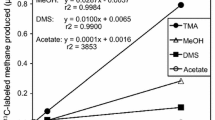Summary
Sulfate ions in the muddy sediments of Lake Vechten are consumed by sulfate-reducing bacteria of which the abundance is limited by the concentration of these ions. Methane producers are found deeper in the mud at lower concentrations of hydrogen sulphide.
The turnover rate constant (k) of L-lactate, calculated from the decline in specific activity of labeled acid, was 2.37 h−1. The average L-lactate pool size was 12.2 µg per gram of wet mud, giving a turnover rate of 28.9 µg of lactate/gram of mud per h. The turnover rate constant of acetate was 0.35 h−1 and the average pool size 5.7 µg per gram of wet mud, giving a rate of disappearance of 2.0 µg of acetate/gram of mud per h.
The formation of C14H4 from [U-C14]-L-lactate, suggests a substrate relationship between sulfate-reducing and methane-producing bacteria. Results of chemostat experiments gave further supporting evidence of such a relationship. The influence of an acetate-producing organism,Desulfovibrio desulfuricans, on the fermentation of limiting amounts of acetate by a methane-producing organism,Methanobacterium sp., was studied in mixed continuous cultures. The results of these experiments indicated the existence of a commensalism.
Similar content being viewed by others
References
Baas Becking, L. G. M., Kaplan, I. R. and Moore, D., Limits of the natural environment in terms of pH and oxidation-reduction potentials. J. Geol.68, 243–284 (1960).
Cappenberg, Th. E., Ecological observations on heterotrophic, methane oxidizing and sulfate reducing bacteria in a pond. Hydrobiologia40, 471–485 (1972).
Cappenberg, Th. E., Interrelations between sulfate-reducing and methane-producing bacteria in bottom deposits of a fresh-water lake. I. Field observations. Antonie van Leeuwenhoek J. Microbiol. Serol.40, 285–295 (1974).
Cappenberg, Th. E., Interrelations between sulfate-reducing and methane-producing bacteria in bottom deposits of a fresh-water lake. II. Inhibition experiments. Antonie van Leeuwenhoek J. Microbiol. Serol.40, 297–306 (1974).
Cappenberg, Th. E., A study of mixed continuous cultures of sulfate-reducing and methane-producing bacteria. Microbiol. Ecology2, (in press) (1975).
Cappenberg, Th. E. and Prins, R. A., Interrelations between sulfate-reducing and methane-producing bacteria in bottom deposits of a fresh-water lake. III. Experiments with14C-labeled substrates. Antonie van Leeuwenhoek J. Microbiol. Serol.40, 457–469 (1974).
Fuhs, G. W., Der mikrobielle Abbau von Kohlenwasserstoffen. Arch. Mikrobiol.39, 374–422 (1961).
Gemerden, H. van, On the bacterial sulphur cycle of inland waters. Thesis, Leiden (1967).
Jeris, J. S. and McCarty, P. L., The biochemistry of methane fermentation using C14 tracers. J. Water Pollut. Control Fed.37, 178–192 (1965).
Lawrence, A. W. and McCarty, P. L., Kinetics of methane fermentation in anaerobic treatment. J. Water Pollut. Control Fed.41, R1-R17 (1969).
Le Gall, J. and Postgate, J. R., The physiology of sulfate-reducing bacteria.In A. H. Rose and D. W. Tempest (eds.), Advances in Microbiol Physiology. Academic Press,10, 81–133 (1973).
Liebmann, H., Zur Biologie der Methanbakterien. Gesundh. Ing.71, 14–22 (1950).
McCarty, P. L., Energetics of organic matter degradation.In R. Mitchell (ed.), Water Pollution Microbiology, Wiley-Interscience, 91–118 (1972).
Stadtman, T. C., Energy-yielding reactions of anaerobic bacteria. In V. Fredette (ed.), The anaerobic bacteria, Proc. Int. Workshop, Laval-des-Rapides, Canada, 25–39 (1967).
Stumm, W., Redox potential as an environmental parameter; Conceptual significance and operational limitation.In O. Jaag (ed.), Advances in Water Pollution Research, Proc. 3° Int. Conf. Water Pollut. Res., Pergamon,1, 283–308 (1967).
Tempest, D. W., The cultivation of micro-organisms: I. Theory of the chemostat.In J. R. Norris and D. W. Ribbons (eds.), Methods in Microbiology, Academic Press,2, 259–276 (1970).
Toerien, D. F. and Hattingh, W. H. J., Anaerobic digestion. I. The microbiology of anaerobic digestion. Water Research3, 385–408 (1969).
Veldkamp, H. and Jannasch, H. W., Mixed culture studies with the chemostat. J. appl. Chem. Biotechnol.22, 105–123 (1972).
Wolfe, R. S., Microbial formation of methane,In A. H. Rose and J. F. Wilkinson (eds.), Advan. Microbial Physiol., Academic Press,6, 107–146 (1971)
Author information
Authors and Affiliations
Additional information
Paper read at the Symposium on the Sulphur Cycle, Wageningen, May 1974.
Rights and permissions
About this article
Cite this article
Cappenberg, T.E. Relationships between sulfate-reducing and methane-producing bacteria. Plant Soil 43, 125–139 (1975). https://doi.org/10.1007/BF01928481
Issue Date:
DOI: https://doi.org/10.1007/BF01928481



